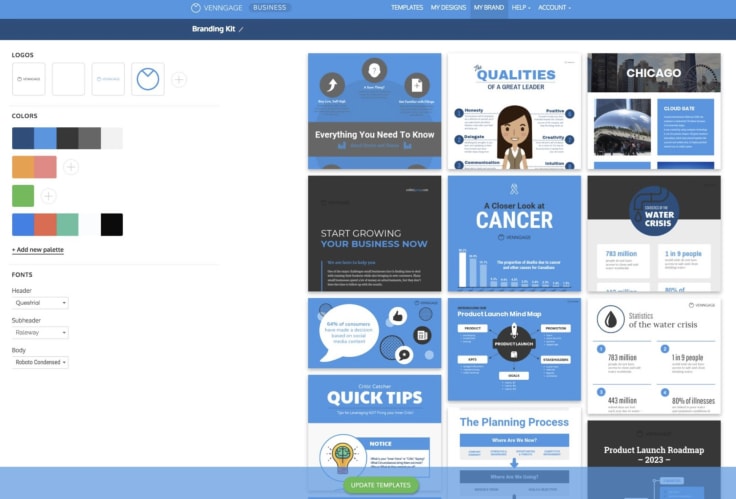Showing top 0 results 0 results found
Showing top 0 results 0 results found

The popularity of digital media has grown immensely in the past few years. As a result, the internet has become suffused with content, and has lead to businesses jostling for space to share their message. But strong messaging alone isn’t enough to create a loyal group of followers and customers. Content needs to be directly tied into your brand identity because brand recognition has become one of the most important aspects of digital marketing.
Your brand identity is the key to your customers recalling your brand when they engage with your content in the digital sphere. The better the brand recognition, the more likely it is that your business will see consistent upward growth. As Michael O’Neill at Brafton explains:
Content marketing is branding, (and branding is content marketing).
While most brands create established brand guidelines fairly early on in their business model, there are still inconsistencies when putting these guidelines into practice for content marketing. To achieve brand recognition, follow these best practices for incorporating brand identity in your digital marketing.
Establish tone of voice
A brand’s identity is more than just the visuals—like the logo and brand colors—it also has to do with the tone of voice you use in your written and verbal content. The way your brand communicates with its audience through digital marketing sets the tone for all other interactions, both digital and print, such as with chatbots, email newsletters, and advertising. Look at this example of a post with a serious tone of voice.

Alongside the visual brand guidelines that your company creates, it is best to have content guidelines, as well. Since tone of voice is tied into your brand’s personality and ethos, you need to decide what kind of tone you want to use—is it informal, irreverent, humorous, friendly, serious, educational, or sarcastic? Some tones of voice are easier to adapt across multiple platforms, while others are not, and that is something you need to consider beforehand.
Let your marketers, freelancers, and ghostwriters know how you want them to communicate with the audience. Set rules that they can follow and share examples of what you are looking for. If you’re looking to create inspirational content, look at Dove’s marketing, or for a more humorous approach, share Cards Against Humanity’s comedic posts.
Whatever tone of voice you decide to adopt, it needs to be able to share your brand story across the digital sphere, and act as a reminder to your audience of what your brand stands for.
Create a Design Kit
Marketing teams generally have design guidelines prepared before the marketing process can begin. These guidelines include logo variations, logo usage, what brand colors to use, and the brand fonts to be adopted across collaterals. Guidelines such as these help to ensure that materials created both in-house and by agencies and freelancers are consistent across the board.
However, with visual content becoming such a key part of digital marketing, a design kit is almost mandatory for creating materials that encourage brand recall. Consistently creating large volumes of high-quality visual content that also encompasses the brand’s identity isn’t an easy task, which is why a design kit is an important tool for visual marketers.
A number of online tools include a ‘my brand kit’ option that allows you to easily input your logo, and add color palettes and fonts in all your materials. Venngage’s brand kit allows you to do all this and more, as you can see in the screenshot below.

By using a design kit, marketers can easily maintain consistency in their designs and tie all the content into the business’ brand identity.
Adopt Templates
Alongside using a brand kit to organize your branding across visuals, it is also beneficial to use templates for visual marketing. Social media templates are a great way to design engaging and attractive content that makes you stand out in the crowded digital sphere. Adopting a particular set of templates for your visuals will help your audience recognize your content immediately.
Templates also allow you to be flexible with the kind of content you create without having to build a visual from scratch every time you need to post. You have the option to change colors, swap icons, and play around with layouts, so your content always looks fresh, but doesn’t require the same level of work that producing new visuals would require. The Instagram post template below can be adapted for a number of events depending on the brand’s needs.

Additionally, templates can be easily used by non-designers, which means that you don’t need to rely on your designers every time new content is needed—your marketing team can quickly change elements and text in a template to reflect new messaging. This gives marketers the flexibility to crank out content at a moment’s notice, that is still reflective of your brand and messaging.
Be Consistent
I have mentioned consistency fairly often in this post, but it needs to be reiterated again. Internet users generally need between 5-7 engagements with your brand to recognize it. Consistency is extremely important in the digital sphere—it is one of the primary ways to ensure brand recall when there is so much content available to audiences.
Your tone of voice needs to be consistent throughout all channels. While it may be tempting to adopt different tones of voice for different platforms, this will be confusing and alienating for the audience. Using an informal tone on social media channels, and a more inspirational one for blog posts, may make sense on an academic level, but from a practical point of view, you are more likely to lose customers who will be unsure whether or not your brand is catering to them across platforms.
There also needs to be consistency across visual design—which is possible with the use of guidelines, brand kits, and templates. Brand colors should be used across websites, social media posts, and newsletters. Similarly with social channel headers, you should be using the same header across Facebook, Twitter, YouTube, and LinkedIn.
Consistency with visuals and tone of voice in digital marketing strategy will help evoke your brand identity to audiences interacting with it.
Cross Promote
To strengthen your brand identity, use cross-promotional campaigns in your digital marketing. Your social posts should be optimized for all channels—use the same visuals and text but the imagery should be the right size for the platform. Include callbacks in your marketing materials to encourage customers to visit your different channels.
For instance, your email newsletters should have prompts to visit your social media pages and your website, and you can even repurpose your social media posts as newsletter headers. Your website should have prompts to visitors to sign up for newsletter subscriptions.
By creating loops in your promotional efforts, you will be able to establish brand recall in the minds of your audience.
Conclusion
Consistency is key to incorporating brand identity in your promotional materials. Once you have an idea of your brand’s personality, establish your tone of voice across your written and verbal communication. Create a design kit and use templates to help your marketers make consistent visual content, and use the content in different ways across the various platforms your brand is maintaining. Following these guidelines, you will be able to leverage your brand identity on digital marketing to reach your business goals.
All images sourced from Venngage.



